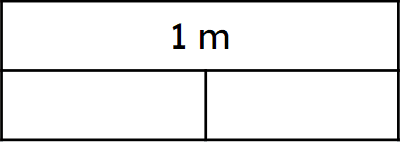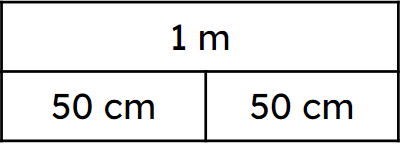Myths about teaching can hold you back
- Year 5
Explain that different lengths can be composed additively and multiplicatively
I can explain that different lengths can be represented as addition and multiplication.
- Year 5
Explain that different lengths can be composed additively and multiplicatively
I can explain that different lengths can be represented as addition and multiplication.
These resources were made for remote use during the pandemic, not classroom teaching.
Switch to our new teaching resources now - designed by teachers and leading subject experts, and tested in classrooms.
Lesson details
Key learning points
- Partitioning 100 in different ways can be used to compose lengths.
- There are four 25s in 100 so there are four 25cm lengths in 1m.
- 1m divided into four equal parts is 25cm or 0.25m.
- 1m divided into five equal parts is 20cm or 0.2m.
Keywords
Common - Something is common when it is frequently used or it occurs regularly.
Compose - Larger numbers can be composed of smaller numbers.
Partition - The act of splitting an object or value down into smaller parts.
Common misconception
Pupils think that when a whole is divided into x parts, they need to have x interval markers.
Encourage pupils to make connections between the bar model and the number line, drawing attention to where each whole has been divided.
To help you plan your year 5 maths lesson on: Explain that different lengths can be composed additively and multiplicatively, download all teaching resources for free and adapt to suit your pupils' needs...
To help you plan your year 5 maths lesson on: Explain that different lengths can be composed additively and multiplicatively, download all teaching resources for free and adapt to suit your pupils' needs.
The starter quiz will activate and check your pupils' prior knowledge, with versions available both with and without answers in PDF format.
We use learning cycles to break down learning into key concepts or ideas linked to the learning outcome. Each learning cycle features explanations with checks for understanding and practice tasks with feedback. All of this is found in our slide decks, ready for you to download and edit. The practice tasks are also available as printable worksheets and some lessons have additional materials with extra material you might need for teaching the lesson.
The assessment exit quiz will test your pupils' understanding of the key learning points.
Our video is a tool for planning, showing how other teachers might teach the lesson, offering helpful tips, modelled explanations and inspiration for your own delivery in the classroom. Plus, you can set it as homework or revision for pupils and keep their learning on track by sharing an online pupil version of this lesson.
Explore more key stage 2 maths lessons from the Use knowledge of decimals to solve problems in different contexts: length unit, dive into the full primary maths curriculum, or learn more about lesson planning.

Licence
Prior knowledge starter quiz
6 Questions
Q1.Convert 2.5 metres into centimetres. cm
Q2.Match the descriptions.
each part has a value of 50
each part has a value of 25
each part has a value of 20.
Q3.What is the missing number on the number line?

Q4.Complete: 0.1 is __________ of 10
Q5.Which equations represent this bar model?

Q6.What is the missing number in this equation? 25 × = 175
Assessment exit quiz
6 Questions
Q1.Match the descriptions.
each part has a value of 0.5 m.
each part has a value of 0.25 m.
each part has a value of 0.2 m.
Q2.Look at the number line. Which letter is pointing to 75 cm?

Q3.In metres, what is the value of each of the partitioned parts? m

Q4.Tick the equations that could represent this number line.

Q5.Tick the image that represents the equation: 0.2 m × 5 = 1 m





